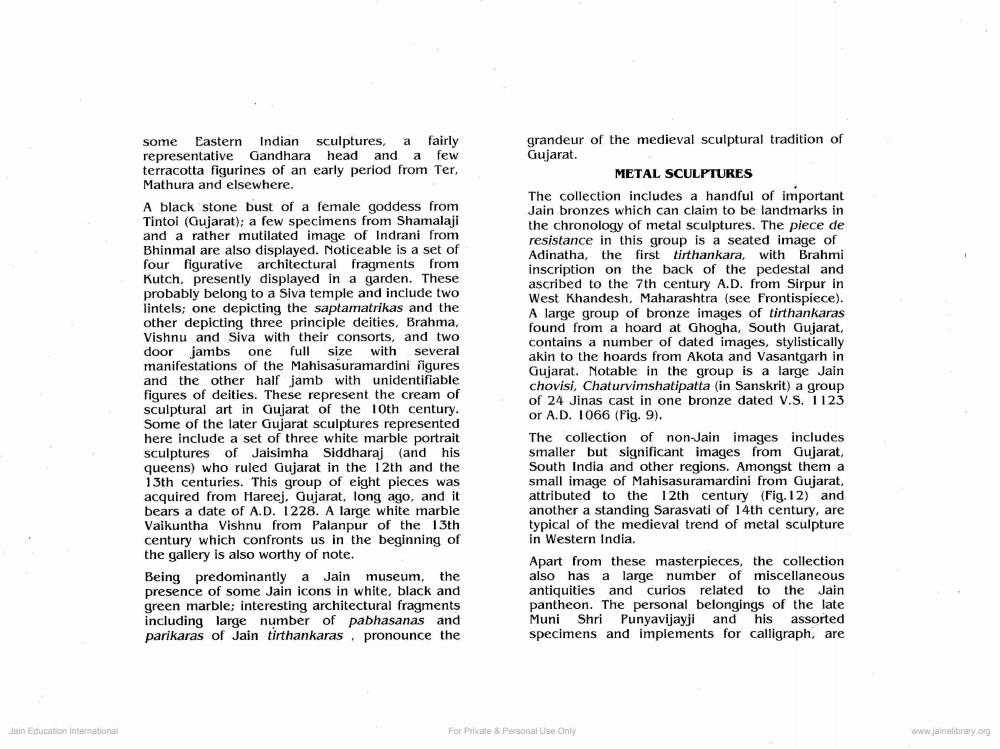Book Title: Treasures from the Lalbhai Dalpatbhai Museum Author(s): L D Indology Ahmedabad Publisher: L D Indology Ahmedabad View full book textPage 7
________________ Jain Education International some Eastern. Indian sculptures, a fairly representative Gandhara head and a few terracotta figurines of an early period from Ter, Mathura and elsewhere. A black stone bust of a female goddess from Tintoi (Gujarat); a few specimens from Shamalaji and a rather mutilated image of Indrani from Bhinmal are also displayed. Noticeable is a set of four figurative architectural fragments from Kutch, presently displayed in a garden. These probably belong to a Siva temple and include two lintels; one depicting the saptamatrikas and the other depicting three principle deities, Brahma, Vishnu and Siva with their consorts, and two door jambs one full size with several manifestations of the Mahisasuramardini figures and the other half jamb with unidentifiable figures of deities. These represent the cream of sculptural art in Gujarat of the 10th century. Some of the later Gujarat sculptures represented here include a set of three white marble portrait sculptures of Jaisimha Siddharaj (and his queens) who ruled Gujarat in the 12th and the 13th centuries. This group of eight pieces was acquired from Hareej, Gujarat, long ago, and it bears a date of A.D. 1228. A large white marble Vaikuntha Vishnu from Palanpur of the 13th century which confronts us in the beginning of the gallery is also worthy of note. Being predominantly a Jain museum, the presence of some Jain icons in white, black and green marble; interesting architectural fragments including large number of pabhasanas and parikaras of Jain tirthankaras, pronounce the grandeur of the medieval sculptural tradition of Gujarat. METAL SCULPTURES The collection includes a handful of important Jain bronzes which can claim to be landmarks in the chronology of metal sculptures. The piece de resistance in this group is a seated image of Adinatha, the first tirthankara, with Brahmi inscription on the back of the pedestal and ascribed to the 7th century A.D. from Sirpur in West Khandesh, Maharashtra (see Frontispiece). A large group of bronze images of tirthankaras found from a hoard at Ghogha, South Gujarat, contains a number of dated images, stylistically akin to the hoards from Akota and Vasantgarh in Gujarat. Notable in the group is a large Jain chovisi, Chaturvimshatipatta (in Sanskrit) a group of 24 Jinas cast in one bronze dated V.S. 1123 or A.D. 1066 (Fig. 9), The collection of non-Jain images includes smaller but significant images from Gujarat, South India and other regions. Amongst them a small image of Mahisasuramardini from Gujarat, attributed to the 12th century (Fig. 12) and another a standing Sarasvati of 14th century, are typical of the medieval trend of metal sculpture in Western India. Apart from these masterpieces, the collection also has a large number of miscellaneous antiquities and curios related to the Jain pantheon. The personal belongings of the late Muni Shri Punyavijayji and his assorted specimens and implements for calligraph, are For Private & Personal Use Only www.jalnelibrary.orgPage Navigation
1 ... 5 6 7 8 9 10 11 12 13 14 15 16 17 18 19 20 21 22 23 24 25 26 27 28 29 30 31 32
